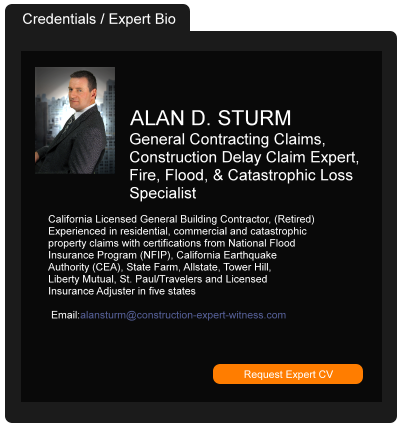California Court of Appeal Adopts Horizontal Exhaustion Rule
June 28, 2013 —
Tred Eyerly, Insurance Law HawaiiIn a long running suit regarding thousands of asbestos bodily injury claims brought against Kaiser Cement and Gypsum Corporation, the California appellate court held that the excess carrier's indemnity obligation did not attach until all collectible primary policies were exhausted. Kaiser Cement and Gypsum Corp. v. Ins. Co. of the State of Pennsylvania, 215 Cal. App.4th 210 (Cal. Ct. App. April 8, 2013).
Kaiser manufactured a variety of asbestos-containing products from 1944 through the 1970's. Truck Insurance Company provided primary insurance to Kaiser from 1964 to 1983, through four CGL policies covering 19 annual policy periods. The policy in effect from 1974 to 1981 contained a $500,000 "per occurrence" liability limit. Kaiser was insured by three other primary carriers between 1947 and 1987. ICSOP issued a first layer excess policy to Kaiser from 1974 through 1976.
Kaiser tendered numerous claims for bodily injury to Truck. By October 2004, Truck's indemnity payments exceeded $50 million and included at least 39 claims that resulted in payments in excess of $500,000. For claims alleging bodily injury in 1974, Kaiser selected Truck's 1974 policy to respond to each of the claims.
Read the court decisionRead the full story...Reprinted courtesy of
Tred EyerlyTred Eyerly can be contacted at
te@hawaiilawyer.com
With Wildfires at a Peak, “Firetech” Is Joining Smart City Lineups
October 21, 2024 —
James P. Bobotek - Gravel2Gavel Construction & Real Estate Law BlogThe
threat of extreme wildfires has doubled in the past 20 years, with almost 20,000 fires blazing across the United States in 2024 alone. These high-intensity fires can be deadly, expensive, and create lingering health and environmental consequences. While we are used to seeing firefighters on the frontlines, researchers hope that next-generation smart technology, augmented by artificial intelligence (AI), will also play a key role in battling these conflagrations. Many municipalities, particularly those near wildfire-prone forests, are beginning to incorporate fire-focused advances (or “firetech”) into their smart city ecosystems.
“Smart cities” are urban centers enhanced by utilities, emergency services,
traffic signals and more that are linked through information and communications technology. Though the concept can spark cybersecurity-related concerns, many locales are gradually implementing many different kinds of smart tech. Following the 2023 wildfire that devastated Maui, for example, Hawaii installed a network of
cloud-based fire and wind sensors that use AI to detect wildfires in real time. Smart tools like these can aid in predicting and discovering fires, streamlining emergency alert protocols, calculating vital analytics and improving firefighter safety. The National Fire Protection Association (NFPA) is
actively studying these innovations, particularly in terms of environmental (smart buildings or robotics), operational (communications) and personnel (PPE sensors or biometrics). Below are a few of the key technologies to watch in this emerging field:
- Smart Sensors. A total of 80 sensors (64 wildfire sensors and 16 wind sensors) were placed throughout Hawaii starting in March of 2024. Attached to existing utility poles, they detect heat in the air, and then engage AI and smart learning to distinguish smoke particles and gases produced by fires from those commonly found in Hawaii’s atmosphere—such as volcanic ash and ocean salt. Positioned in “strings,” the sensors “talk” to each other and send text messages to officials when they find a problem.
Read the court decisionRead the full story...Reprinted courtesy of
James P. Bobotek, PillsburyMr. Bobotek may be contacted at
james.bobotek@pillsburylaw.com
Expect the Unexpected (Your Design Contracts in a Post-COVID World)
April 18, 2023 —
Melissa Dewey Brumback - Construction Law in North CarolinaHave you adapted your post-COVID practice to better plan for the “unexpected” ? In particular, have you looked at–and revised– your professional services contracts to give yourself a little more breathing room for unaccounted issues that may arise? If not, no time like the present.
Don’t like that saying? How about ” a stitch in time saves nine?” No? Still nothing? What about a picture of something so completely unexpected it shocks you– say, a fireman commuting home, in fire-fighting regalia, on a tricycle? Okay, here you go…
Now that I have your attention– you should make it a practice to regularly review and update your professional services agreements, and you should consider issues such as:
- Does your agreement provide for extra compensation if you have to spend more time or a longer period providing construction administration services for material delays or labor shortages? If not, it should.
- Does your agreement have a well-written “act of God” provision– one that includes pandemic/epidemics as part of the “act of God” conditions in which a term may become void? If not, add it now!
Read the court decisionRead the full story...Reprinted courtesy of
Melissa Dewey Brumback, Ragsdale LiggettMs. Brumback may be contacted at
mbrumback@rl-law.com
Does “Faulty Workmanship” Constitute An Occurrence Under Your CGL Policy?
January 08, 2024 —
David Adelstein - Florida Construction Legal UpdatesThere is nothing more scintillating than an insurance coverage dispute, right? Well, some folks would agree with this sentiment. Others would spit out their morning coffee in disagreement. Regardless of where you fall in the spectrum, they are always important because maintaining insurance is a NECESSARY part of business, particularly in the construction industry. The ideal is to have insurance that covers risks you are assuming in the performance of your work.
Sometimes, insurance coverage disputes provide valuable insight, even in disputes outside of Florida. Recently, the Western District of Kentucky in Westfield Insurance Co. v. Kentuckiana Commercial Concrete, LLC, 2023 WL 8650791 (W.D.KY 2023), involved such a dispute. While different than how Florida would treat the same issue, it’s still noteworthy because it sheds light into how other jurisdictions determine whether “faulty workmanship” constitutes an “occurrence” under a commercial general liability (CGL) policy.
Read the court decisionRead the full story...Reprinted courtesy of
David Adelstein, Kirwin Norris, P.A.Mr. Adelstein may be contacted at
dma@kirwinnorris.com
Critical Materials for the Energy Transition: Of “Rare Earths” and Even Rarer Minerals
September 12, 2022 —
Robert A. James, Ashleigh Myers, Shellka Arora-Cox & Amanda G. Halter - Gravel2Gavel Construction & Real Estate Law BlogAs the world pursues ambitious net-zero carbon emission goals, demand is soaring for the critical materials required for the technologies leading the energy transition. Lithium may be the most well-known of these inputs due to its usage in batteries for vehicles and consumer electronics, but roughly 50 other minerals are central to energy transition technologies. During the coming years, producers, manufacturers and end-users will be increasingly exposed to the roles played by “rare earth” elements (roughly, atomic numbers 57 to 71), platinum group metals, and other materials.
The reasons for this heightened interest are simple—even if the underlying environmental, political and technological forces at play are complex:
- Lower-carbon technologies use different materials than carbon-intensive technologies.
The mineral requirements of power and mobility systems driven by renewable, nuclear, hydrogen and fusion energy are profoundly different from those forming the backbone of fossil fuel systems. Minerals such as lithium, nickel, copper, cobalt, and rare earth elements are vital for electric vehicles (EVs), batteries, fuel cells, electricity grids, wind turbines, smart devices, and many other essential and proliferating civilian and military technologies. For example, an offshore wind plant needs 13 times more mineral resources than a gas power plant of a similar size.
Reprinted courtesy of
Robert A. James, Pillsbury,
Ashleigh Myers, Pillsbury,
Shellka Arora-Cox, Pillsbury and
Amanda G. Halter, Pillsbury
Mr. James may be contacted at rob.james@pillsburylaw.com
Ms. Myers may be contacted at ashleigh.myers@pillsburylaw.com
Ms. Arora-Cox may be contacted at shellka.aroracox@pillsburylaw.com
Ms. Halter may be contacted at amanda.halter@pillsburylaw.com
Read the court decisionRead the full story...Reprinted courtesy of
Top 10 Construction Contract Provisions – Changes and Claims
November 03, 2016 —
James R. Lynch – Ahlers & Cressman PLLCThis is the seventh post in our “Top 10 Construction Contract Provisions” series. Prior posts discussed
Price and Payment,
Liquidated Damages,
Consequential Damages – Part I and
Part II,
Indemnity,
Scope of Work, and
Flow-Down Provisions.
Today’s topic, Changes and Claims, is a contender for the top spot on our list, for both day-to-day impact on the job and importance in disputes. In fact, these provisions[i] are so variable and are involved in so many reported construction law decisions, that this post will not attempt to survey all their various forms, uses, or potential legal ramifications, but instead focuses on bottom line “best practices”—questions to consider as a general contractor, subcontractor, or owner when drafting, negotiating, or managing the Changes and Claims provisions of a contract. There is no “ideal” here, and the changes and claims procedures should be suited to the project, owner, contractor(s), likely issues, and other project-specific considerations. Key considerations include the following:
1. How prescriptive is the Change Order process? At one end of the spectrum, a Change Order provision may include requirements for written direction and request by the owner and formal response by the contractor, with pricing and specific supporting data or documentation, in addition to strict timelines for response, execution, and performance, precise methods to determine the resulting contract adjustment, limits on the type or extent of adjustment, or terms defining the effect of a signed Change Order, e.g. to what extent related claims or impacts might be extinguished. At the other end of the spectrum, the Change Order provision might simply recognize that the owner may direct changes, and the parties intend to document the directions and resulting compensation in a Change Order, with no further elaboration. There is no universal ideal on this spectrum. A highly defined and prescriptive process may be appropriate for a complex, high value, multi-stakeholder project on which significant changes are likely. The same process would be an inefficient waste of resources on a small and simple project where significant changes are unlikely and the parties would be unlikely to comply with more formal procedures.
Read the court decisionRead the full story...Reprinted courtesy of
James R. Lynch, Ahlers & Cressman PLLCMr. Lynch may be contacted at
jlynch@ac-lawyers.com
Court Requires Adherence to “Good Faith and Fair Dealing” in Construction Defect Coverage
September 30, 2011 —
CDJ STAFFThe California Court of Appeals has ruled in the case of Allied Framers, Inc. v. Golden Bear Insurance Company. Allied had been sued in a construction defect case and its primary insurer had become insolvent. Coverage for Allied’s defense was paid for by the California Insurance Guarantee Association through June 8, 2006. When warned that CIGA’s involvement was ending, Allied notified Golden Bear, which declined to provide coverage.
In the matters that followed, Golden Bear claimed that Allied had not exhausted its $1 million in primary insurance. Allied then showed that $1 million had already been paid out in the case. A few months thereafter, Golden Bear offered a $500,000 settlement on behalf of Allied which was rejected. Thereafter, Golden Bear hired new counsel to defend Allied. Golden Bear received, but allegedly did not pay, invoices Allied sent from their former counsel. Golden Bear finally settled the construction defect case for $2 million.
Allied’s original counsel sued Allied for payment. Golden Bear declined coverage. Allied then claimed that Golden Bear liable on several counts, arising from its failure to settle the construction defect action earlier than it did and its failure to pay Allied’s counsel. Golden Bear demurred, arguing that Allied had now exhausted is coverage with the $2 million settlement. The lower court sustained Golden Bear’s demurrer, dismissing Allied’s complaints.
The appeal court reviewed Allied’s seven complaints and sustained most of them. However, the court did reverse the trial court’s order in regard to Allied’s complaint that Golden Bear breached an implied covenant of good faith and fair dealing. The appeals court was not convinced that Golden Bear properly evaluated the settlement demand in the underlying construction defect case. The court found three other ways in which Golden Bear’s actions might show bad faith, in refusing to pay defense fees “after promising [Allied] such costs would be paid in full,” “failing to advise Allied about ‘actual or potential negative consequences of agreeing to the proposed settlement,’” and that their choice of counsel “failed to protect [Allied’s] interests in the negotiation.”
Read the court’s decision…
Read the court decisionRead the full story...Reprinted courtesy of
Connecticut Supreme Court Again Asked to Determine the Meaning of Collapse
August 20, 2018 —
Tred R. Eyerly - Insurance Law HawaiiFaced with a series of policies, earlier ones which did not define collapse, newer policies which did, the court determined there was a possibility of coverage under the older policies which did not define collapse. Vera v. Liberty Mut. Fire Ins. Co., 2018 U.S. Dist. LEXIS 100548 (D. Conn. June 15, 2018).
Connecticut courts have faced a rash of collapse cases as a result of cement provided to build house foundations by J.J. Mottes Concrete Co. Many basement foundations built with the concrete have shown cracking and other signs of premature deterioration.
Read the court decisionRead the full story...Reprinted courtesy of
Tred R. Eyerly, Damon Key Leong Kupchak HastertMr. Eyerly may be contacted at
te@hawaiilawyer.com


































































